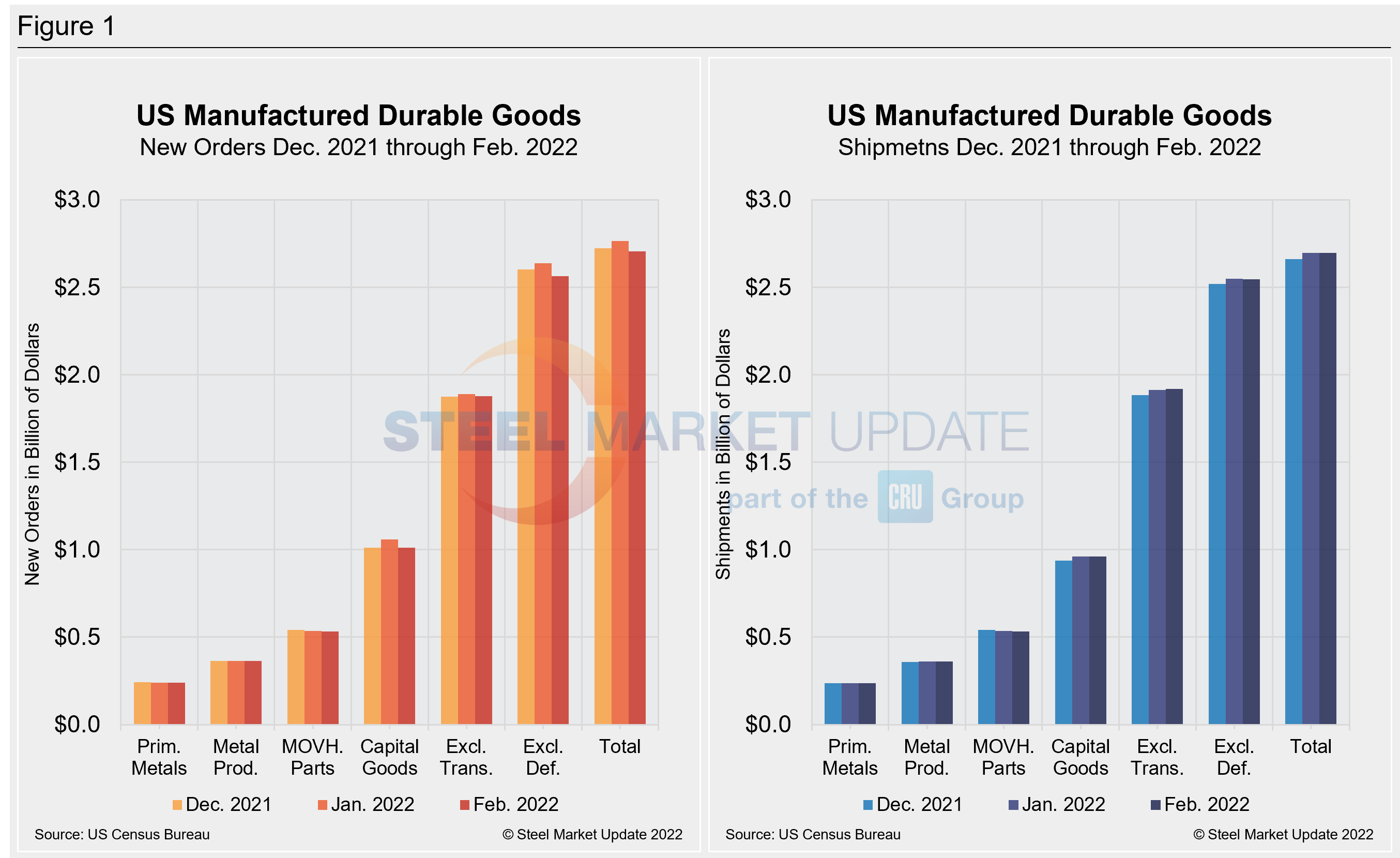Economy

February Durable Goods Sink for First Time in Five Months
Written by David Schollaert
March 29, 2022
New orders for US manufactured durable goods fell 2.2%, or $6.0 billion, in February, snapping a four-month rally, according to the Commerce Department.
Orders at domestic factories for long-lasting goods fell more than expected last month, while business investment fell for the first time in a year. February’s outcome suggests high inflation and ongoing supply shortages are restraining an otherwise strong economic recovery.
![]() The setback in durable goods orders was driven by commercial planes and autos, volatile measures that tend to swing sharply month to month. A more precise measure of demand that excludes transportation and military hardware, known as core orders, fell 0.3% in February.
The setback in durable goods orders was driven by commercial planes and autos, volatile measures that tend to swing sharply month to month. A more precise measure of demand that excludes transportation and military hardware, known as core orders, fell 0.3% in February.
Among the categories in the report, decliners outnumbered gainers five to two, while the catch-all “other durables” category rose 0.8%, and electrical equipment and appliances added 0.2%.
On the downside, transportation equipment sank 5.6%. Within the transportation equipment category, motor vehicles and parts decreased 0.5% as auto manufacturers continue to struggle with chip shortages. Non-defense aircraft lost 30.4%. Defense aircraft, however, jumped 60.1%.
Machinery orders decreased by 2.6%, computers and electronic products fell 1.1%, primary metals were off 0.9%, and fabricated metal products dipped by 0.1%. Still, compared to a year ago, every major category showed gains.
Below is the February advance report from the U.S. Census Bureau on durable goods manufacturers’ shipments, inventories, and orders:
New Orders
New orders for manufactured durable goods in February decreased $6.0 billion, or 2.2% to $271.5 billion, the U.S. Census Bureau announced today. This decrease, down following four consecutive monthly increases, followed a 1.6% January increase. Excluding transportation, new orders decreased 0.6%. Excluding defense, new orders decreased 2.7%. Transportation equipment, down following three consecutive monthly increases, led the decrease, $4.9 billion or 5.6% to $82.6 billion.
Shipments
Shipments of manufactured durable goods in February decreased $0.1 billion, or virtually unchanged at $270.6 billion. This followed a 1.3% January increase. Machinery, down following three consecutive monthly increases, drove the decrease.
Unfilled Orders
Unfilled orders for manufactured durable goods in February increased $5.3 billion, or 0.4%, to $1,288.4 billion. This followed a 0.9% January increase and marked 13 consecutive months of gains. Transportation equipment, up twelve of the last thirteen months, led the increase, up $4.9 billion, or 0.6%, to $853.4 billion.
Inventories
Inventories of manufactured durable goods in February were also up for thirteen consecutive months. They increased $2.0 billion, or 0.4%, to $478.5 billion. This followed a 0.5% January increase. Machinery, up for sixteen consecutive months, led the increase, up $0.8 billion, or 1.0% ,to $80.5 billion.
Capital Goods
Non-defense new orders for capital goods in February decreased $6.5 billion, or 6.7%, to $89.9 billion. Shipments increased $0.2 billion, or 0.2%, to $84.4 billion. Unfilled orders increased $5.5 billion, or 0.7%, to $798.6 billion. Inventories increased $1.4 billion, or 0.7%, to $209.9 billion.
Defense new orders for capital goods in February increased $1.5 billion, or 14.2%, to $12.2 billion. Shipments decreased $0.1 billion, or 0.8%, to $12.9 billion. Unfilled orders decreased $0.7 billion, or 0.4%, to $184.9 billion. Inventories decreased $0.1 billion, or 0.6%, to $21.3 billion.

Revised and Recently Benchmarked January Data
Revised seasonally adjusted January figures for all manufacturing industries were as follows: new orders, $544.7 billion (revised from $544.2 billion); shipments, $537.8 billion (revised from $536.9 billion); unfilled orders, $1,283.1 billion (revised from $1,283.5 billion) and total inventories, $779.8 billion (revised from $779.6 billion).
By David Schollaert, David@SteelMarketUpdate.com

David Schollaert
Read more from David SchollaertLatest in Economy

Steel groups welcome passage of budget bill
Steel trade groups praised the passage of the Big Beautiful Bill (BBB) in Congress on Thursday.

Industry groups praise Senate for passing tax and budget bill
The Steel Manufacturers Association and the American Iron and Steel Institute applauded the tax provisions included in the Senate's tax and budget reconciliation bill.

Chicago PMI dips 0.1 points in June
The Chicago Purchasing Managers Index (PMI) slipped 0.1 points to 40.4 points, in June.

Multi-family pullback drives housing starts to 5-year low in May
US housing starts tumbled in May to a five-year low, according to figures recently released by the US Census Bureau.

Architecture firms still struggling, ABI data shows
Architecture firms reported a modest improvement in billings through May, yet business conditions remained soft, according to the latest Architecture Billings Index (ABI) release from the American Institute of Architects (AIA) and Deltek.
